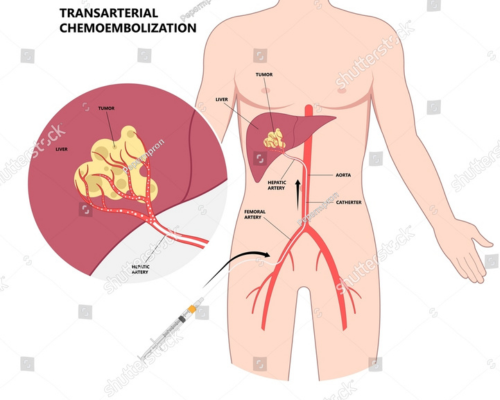Transarterial Chemoembolization (TACE)
What is Transarterial Chemoembolization (TACE)?
Transarterial Chemoembolization (TACE) is a minimally invasive procedure used to treat liver cancer, particularly hepatocellular carcinoma (HCC), as well as other liver tumors. It combines the delivery of chemotherapy directly to the tumor with a procedure to block the blood supply to the tumor. This dual approach effectively targets and kills cancer cells while minimizing the damage to surrounding healthy tissue. TACE is an effective treatment for patients who are not candidates for surgery or liver transplant, offering a way to manage cancer and improve quality of life.
How TACE Works:
TACE is performed by a specialized interventional radiologist using advanced imaging techniques, such as X-ray or CT scans, to guide the procedure. Here’s how it works:
- Catheter Insertion: A small catheter is inserted into the femoral artery (in the groin) and guided through the bloodstream to the liver, where it directly reaches the artery supplying blood to the tumor.
- Chemotherapy Delivery: Once the catheter is in place, a high-dose chemotherapy drug is delivered directly to the tumor. This ensures that the cancer cells receive a potent dose of the drug without affecting the rest of the body.
- Embolization: After the chemotherapy is administered, embolic agents (tiny particles) are injected into the artery to block the blood flow to the tumor. The lack of blood flow causes the tumor to starve, leading to its shrinkage and death.
- Post-Treatment Monitoring: After the procedure, you’ll be monitored for a short time to ensure that the treatment is effective and that there are no complications.
Why Choose TACE?
- Targeted Treatment: TACE delivers chemotherapy directly to the liver tumor, increasing the concentration of the drug at the tumor site while reducing systemic side effects on the rest of the body.
- Minimally Invasive: TACE is performed through a small incision in the groin, eliminating the need for major surgery. This means less pain, fewer risks, and a quicker recovery.
- Effective for Non-Surgical Candidates: TACE is a valuable option for patients with liver tumors who cannot undergo surgery or liver transplant due to the location of the tumors or other health factors.
- Repeatable Treatment: Unlike some treatments, TACE can be repeated if necessary, making it a flexible option for managing liver cancer over time.
- Palliative and Curative Potential: For certain patients, TACE can be used to shrink tumors and control cancer growth, offering a potential for long-term remission. In some cases, it may also be used as a bridge to surgery or a liver transplant.
Who Should Consider TACE?
TACE is recommended for patients who:
- Have primary liver cancer (hepatocellular carcinoma, or HCC): TACE is particularly effective for patients with early to intermediate stages of liver cancer.
- Have tumors that cannot be surgically removed: This includes tumors that are inoperable due to their location or size, or patients who are not candidates for liver transplantation.
- Need tumor shrinkage before surgery: TACE can be used as a bridge therapy to shrink tumors before surgery or liver transplant, making them more operable.
- Have recurrent liver cancer: For patients who have experienced a recurrence of liver cancer after initial treatments, TACE may be an option to manage the disease.
- Are seeking palliative treatment: In some cases, TACE can be used to help alleviate symptoms such as pain or discomfort caused by liver tumors, improving the patient’s quality of life.
What to Expect During TACE:
The TACE procedure is performed in a specialized radiology suite, typically under local anesthesia and sedation. The steps of the procedure are as follows:
- Preparation: You will be positioned comfortably, and the groin area will be cleaned and numbed. Sedation will be administered to keep you relaxed.
- Catheter Insertion: A small catheter is inserted into the femoral artery in the groin. Using real-time imaging, the catheter is guided to the blood vessels feeding the tumor in the liver.
- Chemotherapy Delivery and Embolization: Chemotherapy is directly infused into the tumor, followed by the injection of embolic agents to block blood flow to the tumor.
- Recovery: After the procedure, you will be monitored in a recovery area for a few hours. Most patients can go home the same day or after a short observation period.
Recovery After TACE:
TACE is minimally invasive, but you may experience some mild to moderate side effects after the procedure, including:
- Fatigue: This is common due to the chemotherapy and embolization process.
- Pain or Discomfort: You may experience mild to moderate pain or a sensation of fullness in the abdomen as the liver heals.
- Fever: Some patients develop a low-grade fever after the procedure, which typically resolves within a few days.
- Nausea or Vomiting: Chemotherapy can cause digestive upset, but medications can help manage this.
Most side effects are temporary and improve within a few days to weeks. Your doctor will provide instructions for managing any discomfort and follow-up care. You may need periodic imaging to monitor the effectiveness of the treatment.
Benefits of TACE:
- Minimally invasive with no major surgery
- Highly targeted, delivering chemotherapy directly to the tumor
- Can shrink tumors, improve symptoms, and increase survival rates in certain cases
- Can be repeated if necessary
- Helps manage liver cancer in patients who are not candidates for surgery
Is TACE Right for You?
If you’ve been diagnosed with liver cancer or other liver tumors, and you are seeking a less invasive option to shrink or control the tumor, Transarterial Chemoembolization (TACE) could be the right choice. Our expert team of vascular specialists is here to discuss your condition, guide you through the treatment options, and develop a personalized plan to manage your liver health.
Contact us today to schedule a consultation and learn more about how TACE can help you manage liver cancer and improve your quality of life.

Our Services
- Varicose Veins
- Deep Vein Thrombosis
- Vascular Malformation
- Aortic Aneurysms
- Mesenteric Vasculature
- Acute Limb Ischemia
- Peripheral Arterial Disease
- Stroke Prevention
- Angiography
- Vascular Access for Chemotherapy
- Spider Veins
- Glue Therapy
- Sclerotherapy
- AV Fistula
- Uterine Fibroid Embolisation
- Varicocele Embolisation
- Thyroid Ablation
- TACE
- Prostatic Artery Embolisation
- Varicocele Embolisation
